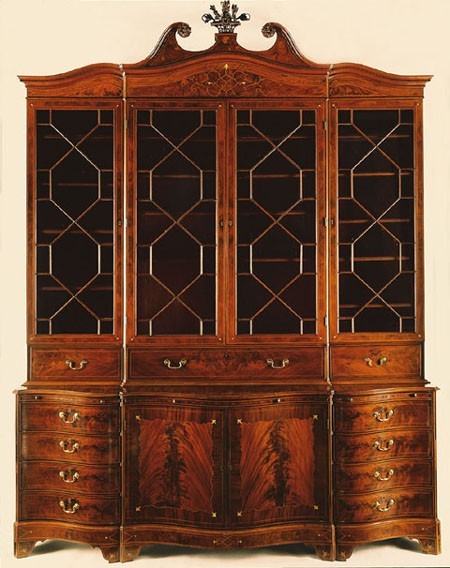
Library bookcase attributed to Martin Pfeninger, Charleston, South Carolina, 1770–1775. Mahogany, mahogany and burl walnut veneer, and ivory and unidentified wood inlays with cypress. H. 128 3/4", W. 99", D. 20 1/2". (Courtesy, Charleston Museum; photo, Gavin Ashworth.)
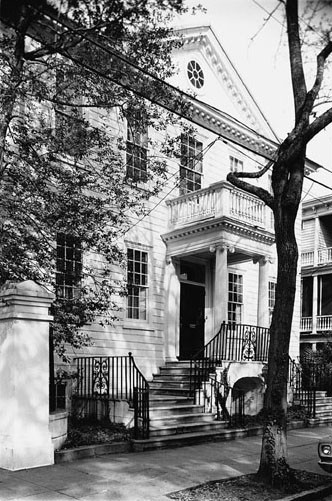
John Edwards House, 15 Meeting Street, Charleston, South Carolina, completed about 1770. (Photo, William Struhs.) This structure is the only surviving eighteenth-century Charleston frame house with a rusticated facade.

The Holmes-Edwards library bookcase as illustrated in Esther Singleton, The Furniture of Our Forefathers (New York: Doubleday, Page and Company, 1901), p. 150. This image indicates that the basket ornament was partially restored by the early twentieth century.
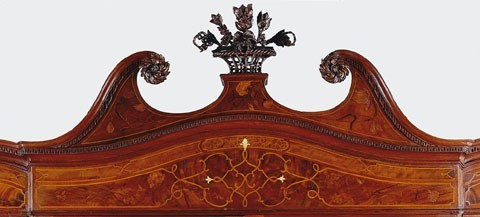
Detail of the pediment of the library bookcase illustrated in fig. 1. (Photo, Gavin Ashworth.) The five straight sprigs with leaves and flowers behind the rose of the basket-and-flower ornament are incorrect replacements.
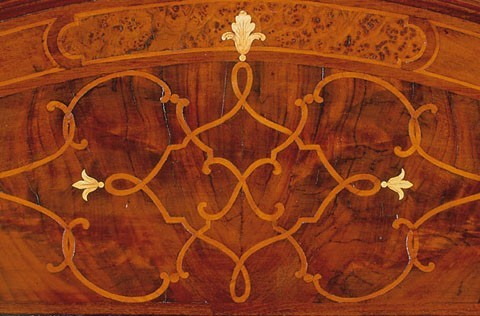
Detail of the scrollwork, mahogany and burl veneer panels, and engraved ivory husks on the frieze of the library bookcase illustrated in fig. 1. (Photo, Gavin Ashworth.)

Detail of the floral marquetry on the frieze and tympanum of the library bookcase illustrated in fig. 1. (Photo, Gavin Ashworth.) The color contrasts of the marquetry were originally stronger.
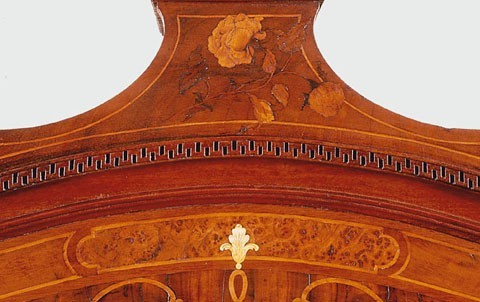
Detail of the floral marquetry on the tympanum plinth of the library bookcase illustrated in fig. 1. (Photo, Gavin Ashworth.)
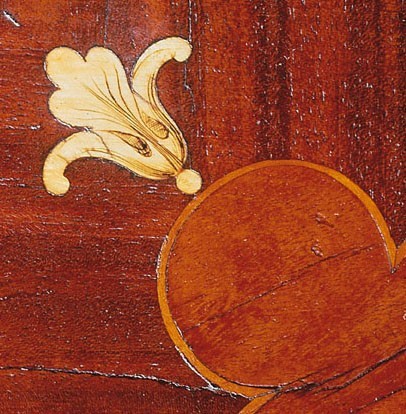
Detail of an engraved ivory husk on a lower door of the library bookcase illustrated in fig. 1. (Photo, Gavin Ashworth.)

Detail of the dustboard construction on the library bookcase illustrated in fig. 1. (Photo, Gavin Ashworth.)
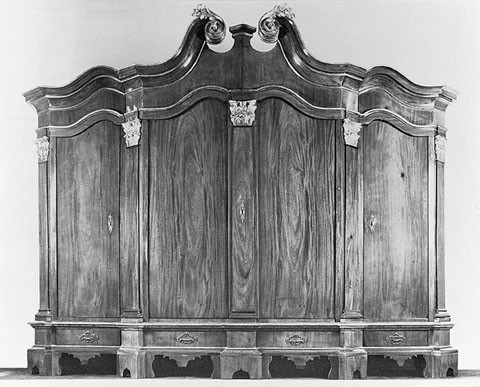
Dielenschrank, Lubeck, Germany, 1760–1770. Woods not recorded. H. 95 5/8", W. 122 13/16", D. 32 1/4". (Illustrated in Wolfgang Schwarze, Antike Deutsche Mobel: das Burgerliche und Rustikale Mobel in Deutschland von 1700–1840 [Wuppertal, Germany: by the author, 1977], p. 16, fig. 17.)

Standuhr, Brunswick, Germany, ca. 1770. Woods not recorded. H. 88 1/2". (Illustrated in Wolfgang Schwarze, Antike Deutsche Mobel: das Burgerliche und Rustikale Mobel in Deutschland von 1700–1840 [Wuppertal, Germany: by the author, 1977], p. 70, fig. 177.)
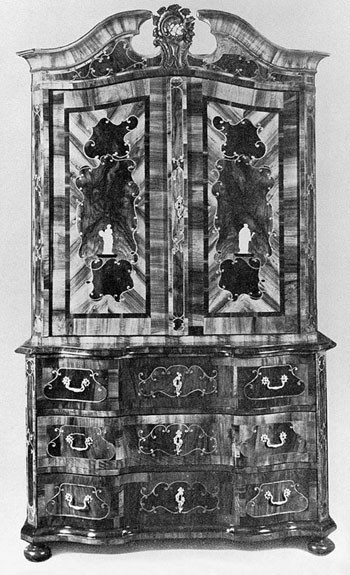
Kommodenaufsatzschrank, Brunswick, Germany, 1750–1760. Woods and dimensions not recorded. (Illustrated in Wolfgang Schwarze, Antike Deutsche Mobel: das Burgerliche und Rustikale Mobel in Deutschland von 1700–1840 [Wuppertal, Germany: by the author, 1977], p. 64, fig. 156.)
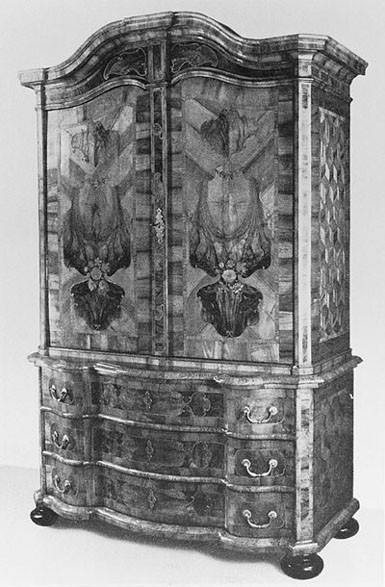
Kommodenaufsatzschrank, Brunswick, Germany, ca. 1750. Woods not recorded. H. 100", W. 58 1/4", D. 29 1/2". (Illustrated in Wolfgang Schwarze, Antike Deutsche Mobel: das Burgerliche und Rustikale Mobel in Deutschland von 1700–1840 [Wuppertal, Germany: by the author, 1977], p. 70, fig. 176b.)

Chest of drawers with inlay attributed to Martin Pfeninger, Charleston, South Carolina, 1775–1782. Mahogany, mahogany veneer, ebonized beech and unidentified lightwood inlays with yellow pine and mahogany. H. 34", W. 41 1/2", D. 24 1/4". (Courtesy, Colonial Williamsburg Foundation.)
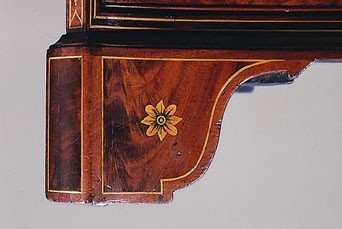
Detail of a bracket foot on the chest of drawers illustrated in fig. 14.

Detail of two bracket feet on the library bookcase illustrated in fig. 1, showing inlays and stringing. (Photo, Gavin Ashworth.)
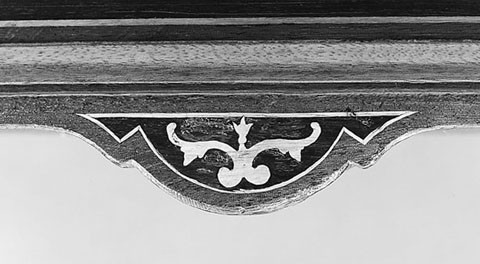
Detail of the base pendant on the chest of drawers illustrated in fig. 14.
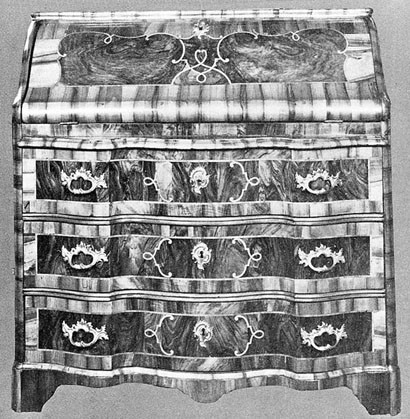
Schreibkommode, Brunswick, Germany, 1750–1760. Woods not recorded. H. 45 1/4", W. 43 5/16", D. 24 13/16". (Illustrated in Wolfgang Schwarze, Antike Deutsche Mobel: das Burgerliche und Rustikale Mobel in Deutschland von 1700–1840 [Wuppertal, Germany: by the author, 1977], p. 64, fig. 154.)

Kommodenschrank, Brunswick, Germany, 1750. Woods not recorded. H. 96 1/2", W. 57", D. 29 1/2". (Illustrated in Wolfgang Schwarze, Antike Deutsche Mobel: das Burgerliche und Rustikale Mobel in Deutschland von 1700–1840 [Wuppertal, Germany: by the author, 1977], p. 63, fig. 153.)
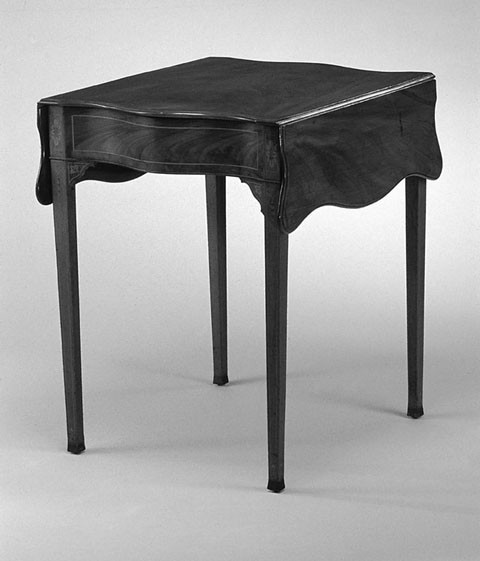
Breakfast table with inlay attributed to Martin Pfeninger, Charleston, South Carolina, 1775–1782. Mahogany, mahogany veneer, and unidentified lightwood inlays with cypress and ash. H. 28 7/8", W. 21 1/2" (closed), D. 243/4". (Private collection; photo, Museum of Early Southern Decorative Arts.)

Detail of the leg and bracket inlay on the breakfast table illustrated in fig. 20.
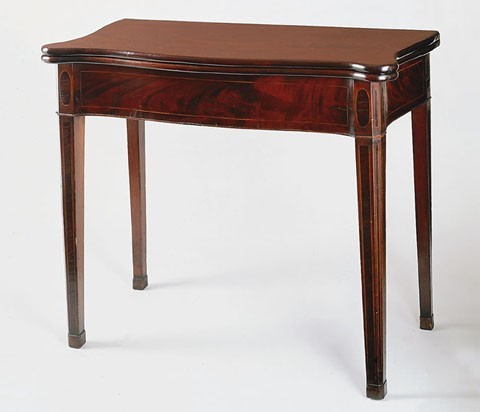
Card table, Charleston, South Carolina, 1775–1785. Mahogany, mahogany veneer, and unidentified lightwood inlay with cypress and mahogany. H. 29 3/8", W. 36", D. 17 13/16" (closed). (Courtesy, Charleston Museum; photo, Gavin Ashworth.)
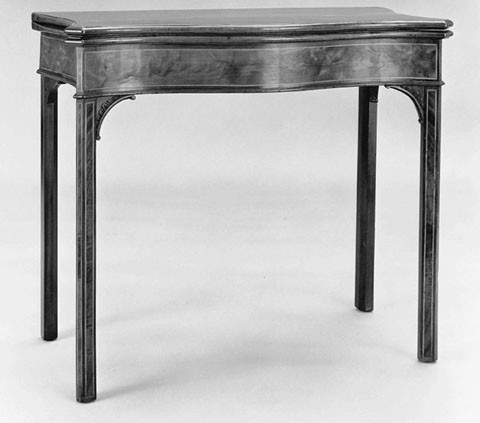
Card table, Charleston, South Carolina, 1770–1785. H. 29 3/8", W. 34 1/2", D. 17 1/2" (closed). (Collection of the Museum of Early Southern Decorative Arts.)
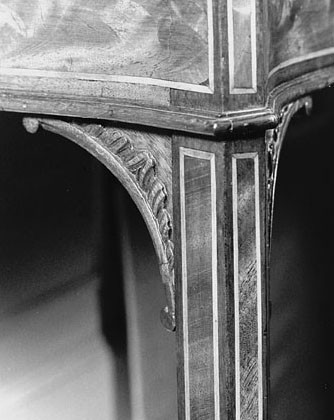
Detail of a carved bracket on the card table illustrated in fig. 23.

Detail of the swing-leg/rail joint of the card table illustrated in fig. 22. (Photo, Gavin Ashworth.)
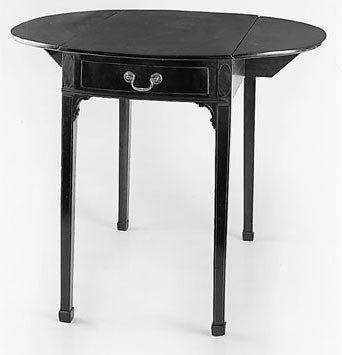
Breakfast table, Charleston, South Carolina, 1775–1785. Mahogany, mahogany veneer, and unidentified lightwood stringing with cedrela, tulip poplar, and white pine. H. 28 1/2", W. 36 1/8" (open), D. 30". (Private collection; photo, Gavin Ashworth.)
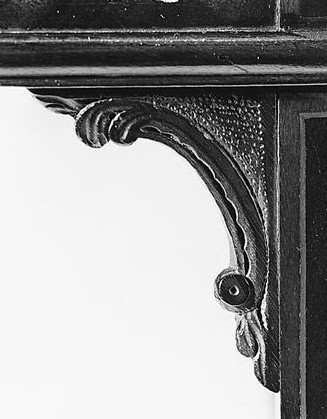
Detail of a carved bracket on the breakfast table illustrated in fig. 26. (Photo, Gavin Ashworth.)
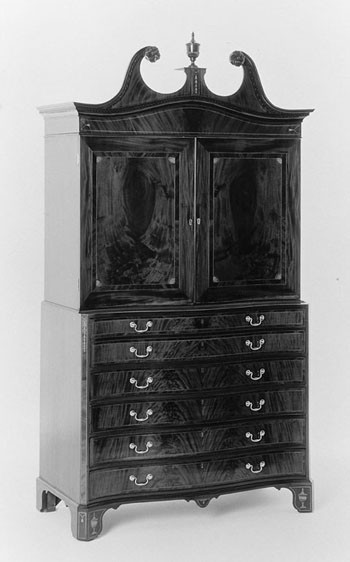
Secretary-press, Charleston, South Carolina, 1780–1790. Mahogany, mahogany veneer, and unidentified lightwood inlays with white pine, cypress, and red cedar. H. 10 5 5/8", W. 56", D. 27 3/4". (Private collection; photo, Gavin Ashworth.) The pediment was altered during the late nineteenth or early twentieth century. Although portions of the swelled frieze are original, the tympanum, scroll moldings, and rosettes are modern restorations.

Library bookcase, Charleston, South Carolina, 1790–1800. Mahogany, mahogany veneer, and unidentified lightwood inlays with red cedar, white pine, and cypress. H. 126 3/8", W. 117", D. 25". (Courtesy, Yale University Art Gallery, Mabel Brady Garvan Collection.) The broken-scroll pediment is a replacement.
The Holmes-Edwards library bookcase in the collection of the Charleston Museum’s Heyward-Washington House is arguably one of colonial America’s greatest cabinetmaking masterpieces (fig. 1). It is also among the least understood. The library bookcase was made for Charleston merchant and South Carolina naval commissioner John Edwards (d. 1781), who emigrated from Bristol, England, about 1750 to engage in Charleston’s burgeoning import and export trade. It is listed in his 1783 probate inventory as a “large Mahogany Book Case” valued at £100 South Carolina currency, and it stood originally in Edwards’s handsome double house at 15 Meeting Street (fig. 2). The library bookcase descended through Edwards’s daughter Elizabeth (ca. 1765–1836), who married attorney John Bee Holmes (1760–1827) on November 19, 1783. For generations in Charleston, it has been known as the “Holmes bookcase.”[1]
Esther Singleton first published an illustration of the library bookcase in The Furniture of Our Forefathers (1901), where she described it as a pre-Revolutionary piece whose “drawers were used by the British officers for horse-troughs” (fig. 3). It appeared again in the January 1936 issue of Antiques, attributed to England and dated 1790. Subsequent publications perpetuated this date, although identification of the library bookcase’s cypress secondary wood prompted scholars to reattribute it to Charleston. By January 1952, the piece had become an icon of Charleston cabinetmaking, appearing as the frontispiece in the thirtieth anniversary edition of Antiques, which featured “Furniture of the Old South, 1640–1820.” More recently, systematic field research by the Museum of Early Southern Decorative Arts has placed the library bookcase at the inception of a cabinetmaking school representing several shops that flourished in Charleston between 1770 and 1795. Many of the details on this piece are repeated on late rococo and neoclassical furniture made just after the Revolution. Although the stylistic impact of the library bookcase has been acknowledged, its design origins and maker have remained elusive.[2]
The past difficulty with stylistic analysis and dating of the library bookcase is understandable, for it represents a synthesis of British and Continental structural and decorative features within the context of Charleston taste and patronage. Its secretary drawer, “Chinese” mullion design, and carved rosettes and basket ornament (fig. 4) are British details, whereas its complex, serpentine base, ogee head, contrasting panels of mahogany and burl veneers outlined with stringing, scrolled strapwork, elaborate floral marquetry, and extensive use of engraved ivory husks (figs. 5-8) are directly related to furniture produced in the German states of Brunswick and Hanover during the third quarter of the eighteenth century. Although the use of naturalistic floral marquetry in concert with scrollwork is found throughout Germany in both rococo furniture and the inlaid cabinet or intarsia rooms commissioned by German electors, dukes, margraves, and prince archbishops and was part of the standard repertoire of mid-eighteenth-century German woodworkers, its appearance on the library bookcase has no parallel in eighteenth-century American furniture.[3]
The construction of the Edwards piece also points to an artisan of Continental descent. The dustboards between the lower drawers are extremely thin, and their beveled edges engage grooves cut in the drawer rails and drawer supports, the latter of which are dadoed to the case sides (fig. 9). This type of “paneled” dustboard system, which also occurs on New York City furniture made between 1730 and 1780, may represent a northern European alternative to the full-bottom dustboards used in most of Charleston’s pre-Revolutionary, British-tradition shops.
If a date of circa 1770 is accepted for its construction, several members of Charleston’s pre-Revolutionary cabinetmaking community emerge as potential candidates for the maker of the library bookcase: Jacob Solvey, “a cabinetmaker” who married Barbara Schmidt in St. John’s Lutheran Church on January 20, 1767; Martin Pfeninger, who first appears in the Thomas Elfe Day Book in May 1772; Jacob Sass, a native of Schenstad, Hesse, who emigrated to Charleston in 1773; Charles Lewis Desel, who married Elizabeth Young in St. John’s Church on March 20, 1774; and Henry C. Gesken, a cabinetmaker of “Osterholtz in Electoral Hanover, Prussia,” who married Maria Margaretha Munch (Minnick) of Crims Creek, Orangeburg County, South Carolina, in St. John’s Church on September 28, 1775.[4]
Two remarkably early references to inlaid work link Martin Pfeninger to the library bookcase. In the April 12, 1773, issue of the South Carolina Gazette and the April 13, 1773, issue of the South Carolina Gazette and Country Journal, he advertised “Cabinetmaking in all its branches, ALSO, INLAID-WORK in any TASTE, by MARTIN PFENINGER At his shop in New-Church-Street, adjoining the SCOTCH-MEETING and Parsonage-House, At the lowest Rates, and in the most expeditious Manner.” The following November, he billed Charleston upholsterer Solomon Smith for “a fine Mahogany Bedstead with a Rich Cornice, Gothic Posts, Carved Swells & Caps, To Inlaid Pedestalls . . . £100.” These documents reveal that Pfeninger was capable of producing highly finished and fashionable rococo forms embellished with a variety of inlaid decoration. His Germanic origins and stated ability to produce inlaid decoration “in any taste” make Pfeninger the leading candidate for the surface decoration, if not the construction, of the library bookcase.[5]
Although rarely produced in other colonial cities, library bookcases were popular in Charleston. The 1771 sale of Thomas Shirley’s household furnishings included “A Mahogany Library case with eight Doors, four above and four below, is nine Feet two-Inches high, and seven Feet wide, has a scroll Pediment Head with dentiled Cornice and Frize; is in nine Pieces for the Convenience of moving, and fixed together with Screws.” Thomas Elfe received £110 for a “Library Book Case” on February 12, 1772; £100 for a “Library Book Case wth Chineas doors & Draws under them” on November 14, 1772; and £110 for a “Library Book Case” on January 23, 1773. The latter example was for merchant Nicholas Langford who had imported “elegant mahogany . . . BOOK CASES, with glass doors and brass locks” from London five years earlier. An unusually large “Mahogany Library [bookcase], Glazed & Ceta 17 feet Long” valued at £100 was among the personal effects abandoned by South Carolina’s last royal governor, Lord William Campbell, when he fled Charleston in 1775. Although the written record is rich in references to the form, only two Charleston library bookcases from the pre-Revolutionary period survive—the Edwards piece and an example based on a design that appeared in all three editions of Thomas Chippendale’s The Gentleman and Cabinet-Maker’s Director.[6]
The earliest reference to Martin Pfeninger is in the Day Book of Charleston cabinetmaker Thomas Elfe. On May 8, 1772, Elfe paid Pfeninger £40 “for work,” a somewhat ambiguous entry since “work” could refer to either labor or a product such as inlay. Whether Pfeninger had just arrived in Charleston or was already established is unknown. Elfe’s Day Book also illuminates the practice of commissioning piece work from specialized artisans such as carver William Crips, as well as from cabinetmakers with their own shops such as Abraham Pearce. Between 1768 and 1775, Pfeninger was one of thirty-eight tradesmen who either labored or provided piece work for Elfe. These artisans included sixteen cabinetmakers, five carpenters, four carvers, three upholsterers, two blacksmiths, two turners, two painters, one joiner, one sawyer, one chairmaker, and one coachmaker.[7]
Pfeninger was almost immediately accepted by Charleston’s Germanic community. On July 17, 1776, he was admitted to the German Friendly Society on the recommendation of tavern keeper Christian Sigwald. The following year, Pfeninger accepted a lot on King Street from Michael Kalteisen, the founder of the society, to settle a debt of £1000 South Carolina currency. Like many other Charleston artisans, Pfeninger suffered during the British blockade of Charleston during the Revolutionary War. In the October 28, 1777, issue of the Gazette of the State of South Carolina, he reported:
MARTIN PFENINGER returns his sincere thanks to the Public in general, and to his Customers in particular, and is sorry the want of materials oblige him to leave off his business of Cabinet-making, &c. Such work as has been bespoke, and now in hand, will be finished as far as the materials he has will go. As soon as materials can be had, he will be obliged to the public and his customers for a continuance of their favours.
In 1781, Pfeninger’s name was among the “List of persons desirous to shew every mark of allegiance to his Majesty.” He died on September 20, 1782, and his will appointed his wife, Hannah, executrix and mentioned his son, Daniel Conrad (see appendix).[8]
Research in Germany and England has failed to identify either Pfeninger’s birthplace or the town or city where he received his training. It is probable that he emigrated directly from Germany to Carolina where he joined Charleston’s burgeoning Teutonic community. During the mid-eighteenth century, the Crown and colony recruited Protestants from the German states, in part to create a buffer against Spanish encroachment and the Native American population on the frontier. On November 23, 1749, Governor James Glen reported: “Germany has been long the Seat of War, and has severely felt the calamities of it; and it may be presumed there are many of her People who wish for a place to rest in which they may enjoy the fruits of their own labour, as many of their countrymen do here.” Assisted by promotional tracts depicting Carolina as a promised land for the poor Protestants of Europe, Charleston merchants rapidly developed a profitable business importing Germans. In 1751, the mercantile firm of Austin and Laurens advertised “about 200 German Passengers [including] . . . several handicraft Tradesmen and Husbandmen, and likely young Boys and Girls . . . to be indented for a term of Years, to any Person who will pay their Passages.” Many of the early Germanic emigrés settled in towns such as Purrysburg and New Windsor on the Santee River, Orangeburg on the Edisto River, Amelia on the Santee River, and Saxe-Gotha on the Congaree River. By the late 1760s, however, some of these settlers had moved to Charleston, bolstering the city’s Germanic population.[9]
St. John’s Lutheran Church and the German Friendly Society served as the main support groups for German immigrants. The stated purpose of the society was to “relieve the distresses of our fellow creatures, and to promote their welfare . . . to support a falling brother—to save a sinking family from ruin—and father the helpless orphan.” To become a member, one had to be at least twenty-one years old, have one parent of Germanic descent, and be able to “speak the German Language intelligibly.” Like other ethnic societies in Charleston, the German Friendly Society advocated fellowship, secrecy, decorum, and a display of strict moral behavior in public. Although many of the early members had origins among the poor immigrant working class, the city’s more successful and socially responsible German tradesmen and businessmen were attracted by the society’s benevolence and philanthropy. Of all the Germanic cabinetmakers working in Charleston before the war, only Pfeninger and Jacob Sass (admitted July 9, 1777) were members.[10]
Although no documentary information regarding Pfeninger’s early career is known, a study of mid-eighteenth-century Germanic cabinetmaking traditions offers clues to his place of origin and training. Given the northern Protestant origins of much of Charleston’s Teutonic population, it is hardly surprising that the closest parallels with the Edwards library bookcase are found on furniture from the northern and northwestern German states. A three-part dielenschrank (fig. 10) from Lubeck is related in having a scrolled pediment and ogee-shaped cornice moldings on the side sections. Made of mahogany with carved and gilded capitals and foliate volutes, this cabinet has Palladian overtones like other German pieces influenced by English furniture styles. Following the accession of George I of Hanover to the British throne in 1714, there was a great deal of stylistic exchange between London and Hanover. Not only did some German cabinetmakers describe themselves as “English,” the term was also applied to certain forms such as Englische Stuhle—a German interpretation of high-backed cane chairs popular in Holland and Britain from about 1680 to 1715. The British export trade in cabinetwares also facilitated the acceptance of English forms such as the bureau and bureau table into the German cabinetmaking tradition.[11]
The influence of German cabinetmakers on British furniture is the subject of Christopher Gilbert and Tessa Murdoch’s John Channon and Brass Inlaid Furniture, 1730–1760. Their research has shown that Moravian artisans were instrumental in shuffling furniture styles between Germany and England during the eighteenth century. Both Abraham Roentgen (1711–1793), founder of the famous cabinetmaking business at Neuweid, and Johann Friedrich Hintz (d. 1772) were Moravians, and the production of British furniture with brass inlay and marquetry “mosaics” has been linked to their presence in London.[12]
Although there is no evidence that Pfeninger was a Moravian or that he spent time in England, there are similarities between the Edwards library bookcase and furniture associated with German cabinetmakers in London, particularly the engraved husks that appear in brass on British examples and in ivory on the Edwards piece. Roentgen specialized in the production of marquetry that combined exotic woods, brass, mother-of-pearl, and ivory. Ivory inlays were popular in Germany from the middle of the seventeenth century, and they remained fashionable in Brunswick and other northern states well into the third quarter of the eighteenth century. The retention of baroque architectural and ornamental details in parts of Germany has been attributed in part to the guild system, which required young tradesmen to produce presentation pieces built according to traditional specifications.[13]
An examination of case pieces made in Brunswick and Hanover during the third quarter of the eighteenth century provides convincing parallels to the Edwards library bookcase. A tall clock case or standuhr (fig. 11) made in Brunswick about 1770 is a standard British form adapted for German taste by the use of exotic veneers, scrolled strapwork, and floral and figural inlays. The inlaid ivory husks are very similar to those on the library bookcase, and the strapwork on both pieces, which features interlocking C and S scrolls connected by inlaid dots, appears to stem from the same shop tradition. Brunswick artisans typically used scrolled strapwork to frame panels of contrasting veneer, which were often made of exotic woods. A slightly earlier kommodenaufsatzschrank from Brunswick (fig. 12), for example, has scroll-outlined panels on the drawers, doors, canted corners, and tympanum, the latter of which are related to the strapwork and scroll-outlined mahogany and burl reserves on the library bookcase. Like many later pieces from Charleston’s German school, the library bookcase has canted corners with string-inlaid panels of contrasting veneer. Although such corners are common on eighteenth-century British furniture, the use of cants for the display of elaborate marquetry and scroll- or strap-outlined panels of contrasting veneer is a hallmark of north German work. The canted corners of the library bookcase and related pieces from Charleston’s German school are closer to the Brunswick prototypes (see figs. 11–13) than to most English examples. The Brunswick kommodenaufsatzschrank illustrated in figure 13 has cants with string-surrounded panels of contrasting veneer, scrollwork reserves on the frieze, and marquetry doors. Elaborate floral marquetry, like that on the frieze of the library bookcase, was extremely popular in the Brunswick region.[14]
The chest of drawers illustrated in figure 14 is closely related to the library bookcase and may be associated with Pfeninger’s shop. Made about 1780, it falls within his Charleston period and exhibits several Germanic features imposed on an essentially British form. These features include the compartmentalization of the surface through the use of three-part string inlays on the edges of the top, sides, drawer fronts, and drawer rails. Also related to the Edwards piece is the use of single-line stringing to outline the veneer panels on the canted corners and bracket feet. Each of these surfaces is further embellished with inlaid rosettes, roundels, and husks, although the execution of these elements has little of the virtuosity displayed by the inlays on the library bookcase. The bracket feet of the two pieces (figs. 1, 15, 16) have a similar S-curve profile. This basic foot design, often with conforming string inlay, occurs on later examples from Charleston’s German school as well as on coastal New England work. Similar feet occur on a secretary-and-bookcase made and labeled by Salem, Massachusetts, cabinetmaker William Appleton about 1795 (see John Bivins’s article in this volume, p. 82, fig. 28) and on a chest made by Portsmouth, New Hampshire, cabinetmaker Langley Boardman (in the collection of the Society for the Preservation of New England Antiquities) about 1800. After the Revolution, New England styles had a powerful influence on Charleston furniture. The foot inlays on the Edwards library bookcase (fig. 16) also relate to the pendant inlay on the chest (fig. 17). Both designs may derive from partie and contrapartie marquetry, particularly those on the library bookcase that have fine shading cuts like metal engraving.[15]
The convex, canted corners on the front feet of the chest are another Germanic feature (fig. 15). Although baroque ball feet remained popular in the Brunswick-Hanover region through the third quarter of the eighteenth century (see figs. 12, 13), the schreibkommode and kommodenschrank illustrated in figures 18 and 19 indicate that bracket feet with convex cants were fashionable alternatives. The former piece also has a veneered base pendant and panels of contrasting veneer with looped scrollwork like that on the frieze of the Edwards piece. The kommodenschrank is noteworthy in having a swelled molding above the doors—a common feature on north German case furniture and architecture—and in having floral marquetry on the tympanum, another feature associated with the library bookcase.
A serpentine breakfast table with floral inlays attributed to Pfeninger (fig. 20) is roughly contemporary with the chest of drawers, although its basic form relates to “Chinese” examples made during the mid to late 1760s. The dogwood-like blossoms on the upper leg stiles and brackets have fine shading cuts that resemble those on the foot inlays of the library bookcase and chest of drawers (figs. 15, 16, 21). Like the chest of drawers (fig. 14), the table also has double-ogee stringing with lightwood husk drops. The most elaborate neoclassical inlay in Charleston dates from the late 1770s and 1780s and includes both locally made products and the distinctive, white-background floral inlays traditionally considered a hallmark of Charleston work but probably imported from Britain.
Also illustrating the transition from late rococo to early neoclassical style is a group of sideboard tables, card tables, and breakfast tables, many of which have elaborate veneers, stringing, and carving. The card table illustrated in figure 22 is one of the earliest in the group. It is contemporary with the chest of drawers (fig. 14), and it has a “commode” front, pentagonal legs, string-outlined panels of contrasting mahogany veneer, an applied astragal molding on the lower edge of the rails, serpentine sides, and a conforming top with projecting rounded corners—details associated with pre-Revolutionary furniture from Charleston’s German school and contemporary work from the Brunswick-Hanover region. The card table also has term feet like the breakfast table with inlay attributed to Pfeninger (fig. 20).
An early transitional card table (figs. 23, 24), with carved rococo brackets and cants similar to those of the chest of drawers and Edwards library bookcase, is related to the example shown in figure 22. It has similar serpentine side rails that are notched to house the swing leg rather than a swing leg notched to lap over the rail (fig. 25), but the tables are probably from different shops. This construction detail occurs on several Charleston card tables made during the 1770s and 1780s. On the table illustrated in figure 23, the rail veneers pass over the leg joints and those on the sides extend to the back edge of the frame. A Charleston breakfast table (fig. 26) combines elements of both card tables, including carved brackets (fig. 27), astragal rail moldings, and oval veneer panels.
A secretary-press (fig. 28) and a library bookcase (fig. 29) document the influence of Pfeninger’s shop on post-Revolutionary furniture from Charleston’s German school. The secretary-press is one of the earliest pieces of American neoclassical furniture and, viewed within the context of the Edwards piece, it represents a transition from the early phase of the German school, where Continental influences dominated, to the later phase, where coastal trade introduced late rococo and early neoclassical styles from the Massachusetts Bay region. The swelled head, inlaid cants with veneered panels and husks suspended from ogee-shaped stringing, and inlaid base pendant of the secretary-press have parallels on both the library bookcase and chest of drawers attributed to Pfeninger. Research by John Bivins suggests that the secretary-press may be associated with the shop of Jacob Sass, who was a contemporary of Pfeninger and who continued to work after the war. The case construction, foot and molding profiles, and “coopered,” veneered doors are closely associated with those on a magnificent serpentine clothespress (see Bivins, p. 66, fig. 16.) The quarter-fans on the doors, urns (restored from evidence of the originals) on the bracket feet, and nine-husk drops suspended from inlaid rings on the cants of the lower case represent one of the earliest appearances of these motifs in Charleston, as well as document the assimilation of British neoclassical inlay styles that influenced other cabinetmaking centers including Norfolk, Virginia, and the Massachusetts Bay region.
The library bookcase (fig. 29) reportedly belonged to Colonel William Alston (1756–1839), a wealthy South Carolina planter whose primary country seat, Clifton, stood on the Waccamaw River near Georgetown. Following his marriage to Mary Brewton Motte in 1791, Alston purchased the Miles Brewton House (completed 1769) on King Street, arguably Charleston’s most palatial, surviving pre-Revolutionary townhouse. He may have commissioned the library bookcase for his city residence shortly thereafter. Like the preceding secretary-press, the library bookcase probably represents the work of a journeyman associated with Pfeninger. The patterns used to lay out the lower case appear to be the same as those used for the Edwards piece. The ornament on the Alston example represents a significant departure from the baroque inlays and marquetry of Pfeninger. The cross-banding on the drawers and doors of the base, quarter-fan inlays, and neoclassical lightwood husks are Charleston interpretations of British neoclassical details. The only decorative similarity between the library bookcases is the husk placement and ogee termini of the stringing on their base plinths. During the twenty-year span between the production of the Edwards library bookcase and the Alston example, Continental influences waned as British and American neoclassical styles became more fashionable; yet, later reiterations of the late baroque details introduced by Pfeninger remained part of Charleston’s unique neoclassical vocabulary.[16]
The written record of Martin Pfeninger’s Charleston career documents his ability to produce inlay “in any taste,” his pursuit of cabinetmaking “in all its branches,” and his shop’s completion of a sumptuous bedstead with carving, a rich cornice, Gothic clustered-column posts, and inlaid pedestals. After working for Thomas Elfe in 1772, he established a shop the following year on the corner of Tradd and Meeting (New Church) Streets, a highly visible location situated among the city’s most impressive townhouses. Given this documentary evidence and his Germanic background, an attribution of the Edwards library bookcase, chest of drawers (fig. 14), and tables illustrated in figures 20–23 to Pfeninger’s shop is reasonable and establishes his reputation as one of Charleston’s most influential late colonial craftsmen.
ACKNOWLEDGMENTS
For assistance with this article the author thanks Luke Beckerdite, John Bivins, Johannes Emter Graf, the late Helena Hayward, Ronald Hurst, Robert Leath, Christopher Loeblein, Jonathan Poston, Jim and Harriet Pratt, Karen Rabe, Sigrid Sangl, and George Williams.
Appendix
Will of Martin Pfeninger
In the Name of God Amen. I Martin Pfeninger of the Town of Charles town Cabinet Maker, being in perfect Health of Body and of sound Mind and Memory, Thanks be unto God for the same; but calling to Mind the Uncertainty of this transitory Life, and knowing that it is appointed for all Men once to die, do make and ordain this my last Will and Testament, that is to say principally and first of all, I give and recommend my Soul into the Hands of Almighty God that gave it, and my Body I recommend to the Earth to be buried in a decent Christian Burial at the Discretion of my Executor, and as these troublesome Times will admit. Nothing doubting but at the general Resurrection I shall receive the same again by the mighty Power of God. And as touching such worldly Estate wherewith it has pleased God to blefs me in this Life, I give demise and dispose of the same in the following Manner and Form. Imprimis. I give and bequeath to Hannah my dear beloved Wife one Negro Fellow named London, and a Negro Woman named Chloe to her own proper Use and Behoof for ever, the rest of my Property what remains, after my Son’s Share which I hereafter bequeath to him excepted, shall remain in the said Hannah’s Hands paying out of the same all my just and lawful Debts, not to be done by public Vendue, but only sell so much as is sufficient to pay said Debts, and do with the rest according as she may please. Secondly I give and bequeath unto my Son Daniel Conrad, a Negro Wench named Byna, and a Negro Girl named Hannah, also the House and Lott adjoining to Mrs. Burn’s near the Draw-gate in Charlestown, containing 150 feet in Depth, and 53 feet in front, also my Gildt Watch, my Riding Horse Hunter and black Colt, likewise my new Rifle and Shot Gun him and his lawful Heirs for ever. But in Case the said Daniel Conrad should happen to die before his Mother, then it is my Will and Desire that the aforesaid Hannah his Mother shall inherit what is bequeathed to him, and in the like Case if the Mother Hannah should happen to die before him, the said Daniel Conrad, then this is my Desire that he shall inherit all what the said Hannah his Mother is pofsefs’d of at the Time of her Decease. But should it happen that they both of them die in a single State of Life, in that Case it is my Desire that my Estate shall be divided in three Parts or Shares VIZ. Sarah Fowler one Share, Sophia West one Share and Martin West one Share, with this Provise that he retains the Name of Martin, otherwise that Share to be divided between Elizabeth west and the said Martin or her Brother. And I do hereby constitute make and ordain the aforesaid Hannah my Wife the sole Executrix of this my last Will and Testament. And I do hereby utterly Disallow, revoke and disannul all and every other former Testaments, Wills, Legacies Bequests and Executers, by me in any wise before named, willed and bequeathed, ratifying and confirming this, and no other, to be my last Will and Testament, in witness whereof I have hereunto set my Hand and Seal, this twenty fourth day of March in the Year of our Lord one thousand seven hundred and eighty,
Martin Pfeninger (LS)
Signed Sealed Published pronounced and Declared by the said Martin Pfeninger as his last Will and testament, in the Presence of us, who in the Presence of each other, have hereunto subscribed our Names, vizt.
John Christian Smith
George F. Dener
James Carmichael
Proved before Charles Lining Esq r O.C.T.D. April 2d 1783.
At same Time qualified Hannah Pfeninger Exix.
Examined 8 Co. Sh. ) C.L.
Source: Charleston Will Book A, 1783–86, p. 64.
